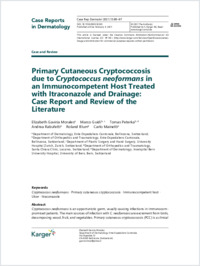Primary cutaneous cryptococcosis due to Cryptococcus neoformans in an immunocompetent host treated with itraconazole and drainage : case report and review of the literature
- Gaviria Morales, Elizabeth Faculty of Biomedical Sciences, Università della Svizzera italiana, Switzerland - Department of Dermatology, Ente Ospedaliero Cantonale, Bellinzona, Switzerland
- Guidi, Marco Department of Orthopedics and Traumatology, Ente Ospedaliero Cantonale, Bellinzona, Switzerland - Department of Plastic Surgery and Hand Surgery, University Hospital Zurich, Switzerland
- Peterka, Thomas Department of Orthopedics and Traumatology, Ente Ospedaliero Cantonale, Bellinzona, Switzerland - Department of Orthopedics and Traumatology, Santa Chiara Clinic, Locarno, Switzerland
- Rabufetti, Andrea Department of Dermatology, Ente Ospedaliero Cantonale, Bellinzona, Switzerland
- Blum, Roland Department of Dermatology, Inselspital Bern University Hospital, University of Bern, Switzerland
- Mainetti, Carlo Faculty of Biomedical Sciences, Università della Svizzera italiana, Switzerland - Department of Dermatology, Ente Ospedaliero Cantonale, Bellinzona, Switzerland
-
04.02.2021
Published in:
- Case reports in dermatology. - 2021, vol. 13, no. 1, p. 89-97
English
Cryptococcus neoformans is an opportunistic germ, usually causing infections in immunocompromised patients. The main sources of infection with C. neoformans are excrement from birds, decomposing wood, fruit, and vegetables. Primary cutaneous cryptococcosis (PCC) is a clinical entity, differing from secondary cutaneous cryptococcosis and systematic infection. We report the case of an immunocompetent 60-year-old woman with PCC due to C. neoformans in her right thumb. She reported an accidental injury caused by a rose thorn while she was gardening. Clinical examination showed the presence of an erythematous ulcerated nodule with elevated borders, suppuration, and central necrosis. Skin histology examination showed cutaneous and subcutaneous fibrinoid necrosis with bleeding, abscess, neutrophil-rich cellular infiltration, and the presence of PAS-, Grocott- and mucin-positive spores. The mycological culture showed milky and creamy colonies of C. neoformans after 3 days. As there was no previous history of pulmonary cryptococcosis, we diagnosed PPC. We treated the patient surgically with accurate debridement of nonvital tissues in the right thumb. In addition, we started itraconazole treatment 100 mg twice daily for 6 months, which led to rapid clinical improvement without relapse. PCC is a rare infection that can present with quite unspecific clinical pictures including acneiform lesions, purpura, vesicles, nodules, abscesses, ulcers, granulomas, pustules, draining sinuses, and cellulitis. Prolonged systemic antifungal therapy is necessary in order to get a healing result without relapse. We summarize all the cases of PCC in immunocompetent patients published so far in the literature.
- Language
-
- English
- Classification
- Pathology, clinical medicine
- License
- Open access status
- gold
- Identifiers
-
- RERO DOC 333387
- DOI 10.1159/000512289
- ARK ark:/12658/srd1319279
- Persistent URL
- https://n2t.net/ark:/12658/srd1319279
Statistics
Document views: 230
File downloads:
- Fulltext: 206
